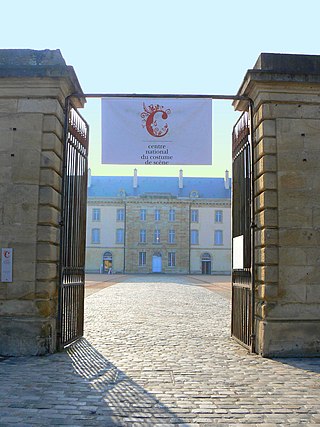
Meteor Crater, or Barringer Crater, is an impact crater about 37 mi (60 km) east of Flagstaff and 18 mi (29 km) west of Winslow in the desert of northern Arizona, United States. The site had several earlier names, and fragments of the meteorite are officially called the Canyon Diablo Meteorite, after the adjacent Canyon Diablo.

Rudolf Khametovich Nureyev was a Soviet-born ballet dancer and choreographer. Nureyev is regarded by some as the greatest male ballet dancer of his generation.

Sunset Crater is a cinder cone located north of Flagstaff in the U.S. state of Arizona. The crater is within the Sunset Crater Volcano National Monument.
Nureyev, Nureev, Nuriyev, or Nuriev is a Russianized Muslim masculine family name meaning "light". Its feminine counterpart is Nureyeva, Nureeva, Nuriyeva, or Nurieva. It may refer to:
Nureyev (1977–2001) was an American-bred, French-trained Thoroughbred racehorse and champion sire. As a racehorse, he was best known as the disqualified "winner" of the 2000 Guineas in 1980.

Koga is an impact crater on Mars, approximately 19 kilometers in diameter. It is located at 29.3°S, 103.8°W, north of the crater Virrat and northeast of the crater Dinorwic. To the north is the crater Nhill. It is named after a town in Tanzania, and its name was approved by the International Astronomical Union in 1991. According to a surface age map of Mars based on US Geological Survey data, the area around Koga is from the Noachian epoch, which places the area's age at 3.8 to 3.5 billion years ago. Sharp blocks and cliffs poke through a mantle of fine material located at the bottom of the crater. At the deepest part of the crater, it is about 5,200 meters in elevation above zero altitude, and its rim averages about 6,400 meters above zero altitude. It is therefore approximately 1.2 kilometers deep.

Sinan is an impact crater on the planet Mercury, 134 kilometers in diameter. It is located northeast of the crater Yeats and southeast of the crater Li Po. It has one craterlet on the south-southwestern side of the crater floor, and it has a symmetrical pit slightly west of the center. Together with a smaller unnamed crater on its southern border, the crater Sinan forms a shape similar to that of the spade found in card games. The crater is named after Mimar Sinan, a 16th-century Turkish architect. The name was adopted by the International Astronomical Union in 1976.
Le Bourgeois Gentilhomme refers to two different ballets by George Balanchine set to Richard Strauss's Concert Suite (1917), with a libretto after Molière's 17th-century comédie-ballet of the same name.

Tir Planitia is a large plain on the planet Mercury. The name Tir (تیر) is the Persian word for "Mercury",, and the name was approved in 1976. It was first observed in detail by Mariner 10. It lies between the large crater Mozart and the ancient Tolstoj basin.

Verdi is an impact crater on the planet Mercury. It was named after Italian Romantic composer Giuseppe Verdi (1813–1901) in 1979, as recognized by the International Astronomical Union. The crater's extensive ejecta blanket and secondary crater field are superposed on plains materials and older craters.

Hemingway is a crater on Mercury. It has a patch of very dark material located near its center. The dark color is likely due to rocks that have a different mineralogical composition from that of the surrounding surface.

Vienna State Ballet, Wiener Staatsballett, is considered one of the world's top ballet companies. It was formerly named the Vienna State Opera Ballet as it is based at the Vienna State Opera building. In 2005 the ballets of the Vienna State Opera and the Vienna Volksoper were merged under the name Das Ballett der Wiener Staatsoper und Volksoper and Gyula Harangozo became the artistic director. On 1 September 2010, a further name change was accompanied by a change in leadership. Manuel Legris, former principal dancer with the Paris Opera Ballet, succeeded as the artistic director.

Amru Al-Qays is a crater on Mercury. The crater was first imaged by Mariner 10 in 1974. Its name was adopted by the IAU in 1976, after the pre-Islamic Arab poet Imru' al-Qais in honor of his impact on astronomy and the world.

Carducci is a crater on Mercury. It has a diameter of 108.19 kilometers. Its name was adopted by the International Astronomical Union (IAU) in 1976. Carducci is named for the Italian poet Giosue Carducci, who lived from 1835 to 1907.

Copley is a crater on Mercury. It has a diameter of 34 kilometers. Its name was adopted by the International Astronomical Union (IAU) in 1976. Copley is named for the American painter John Singleton Copley, who lived from 1738 to 1815.

Dickens is a crater on Mercury. It has a diameter of 78 kilometers. Its name was adopted by the International Astronomical Union (IAU) in 1976. Dickens is named for the English novelist Charles Dickens, who lived from 1812 to 1870.

Hitomaro is a crater on Mercury. It has a diameter of 105 kilometers. Its name was adopted by the International Astronomical Union (IAU) in 1976. Hitomaro is named for the Japanese poet Kakinomoto no Hitomaro, who lived from the 650s to roughly 709.

Centre National du Costume de Scene (CNCS) is a French museum dedicated to stage costumes and sets.

Anguissola is a crater on Mercury. It has a diameter of 35.41 kilometres. Its name was adopted by the International Astronomical Union (IAU) on August 4, 2017. Anguissola is named for the Italian painter Sofonisba Anguissola.

Louth is an impact crater on Mars located at 70.19°N 103.24°E in the Mare Boreum quadrangle. Located within Vastitas Borealis, the crater has a diameter of 36.29 kilometres and is named after Louth, a town in Ireland.



















